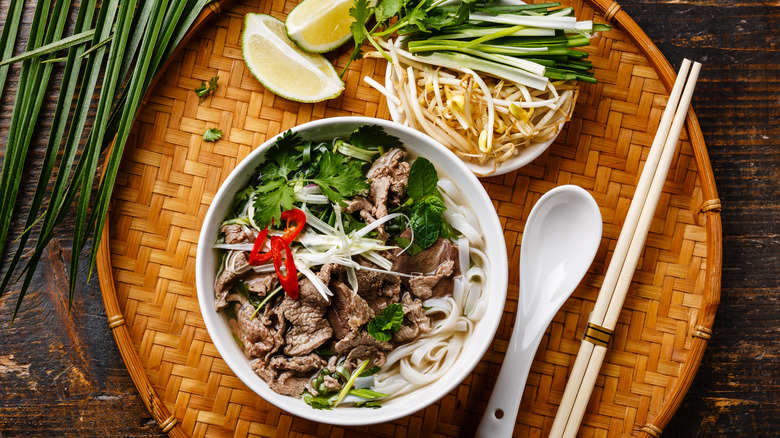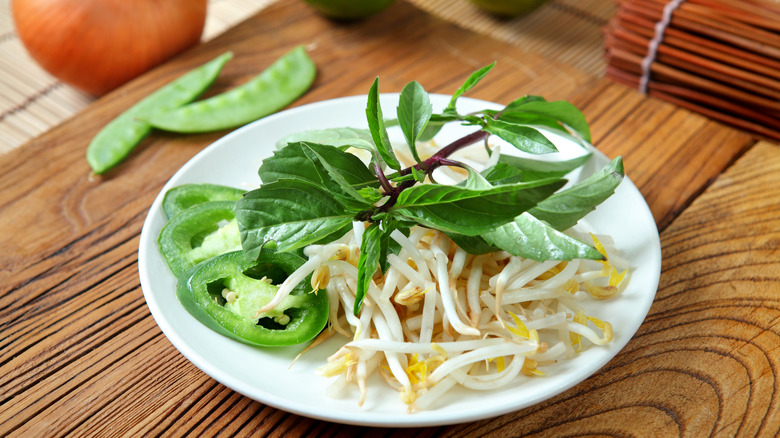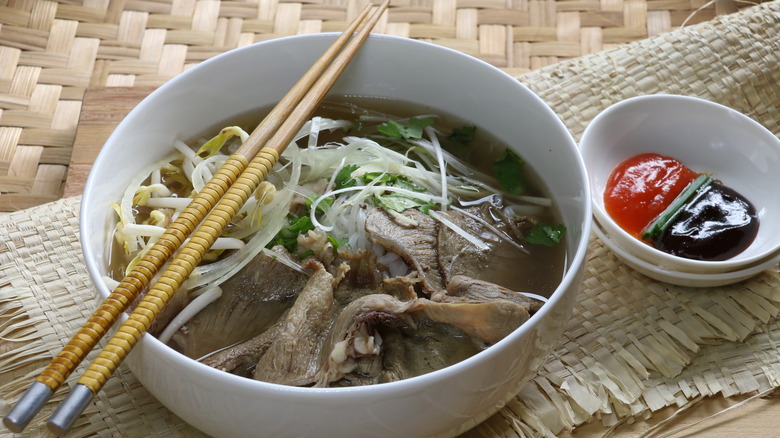How To Eat A Bowl Of Pho Like You Know What You're Doing
If you have ever dined in a Vietnamese restaurant, chances are you have seen a variety of noodle dishes on their menu, including different types of noodle soup called phở. Arguably the most famous dish in Vietnamese cuisine, phở is enjoyed in all corners of the Southeast Asian nation as a breakfast dish.
At its core, a bowl of phở contains three elements: noodles, broth, and toppings. Just like sushi is defined by the use of vinegared rice, phở is defined by the use of rice noodles (also named phở). As a result, there are countless local and regional variations of the dish. For example, northern Vietnamese phở tend to have clear broths while southern Vietnam broths are cloudy and sweeter.
However, while the dish is widely available, many diners have no clue how to approach the dish properly. So how do you eat pho? Do you start with the broth or the noodles? Why is there a plate of greens on the table? What do you do with the sauces? Lift the bowl or use a spoon? Fortunately, there are tips you can use to maximize your enjoyment of each and every element of the dish, and they can all be summarized with three words: sip, season, and dip.
Sip the broth, then season your pho
To enjoy a bowl of phở like an expert, start with the broth. Depending on your order, the broth can be made with chicken (phở gà), beef (phở bò), or seafood (phở hải sản). It is one of the most important elements of the dish, and hours of careful simmering are spent to coax the most flavor from all the ingredients. Therefore, when a bowl of phở arrives at your table, the first thing you should do is try the broth before adding any seasoning. Dip your spoon into the liquid and gently sip the hot broth and savor its flavor.
After enjoying a couple of spoonfuls of the liquid, the next step is to examine the plate of greens that came with your bowl, usually consisting of several types of herbs, sliced chilis, bean sprouts, and a couple of wedges of lime. It is up to you when deciding how to garnish your phở. The bean sprouts are there to provide some textural contrast to the soft noodles while the lime, the chili, and the herbs — typically a mix of cilantro, culantro, mint, and Thai basil — are there to add additional seasoning to the dish. Feel free to experiment with all of them to determine what you like. Tear the herbs before sprinkling them into the broth, so their flavor can sink into the soup. Try eating the noodles with some bean sprouts and appreciate the crunch alongside the noodles.
Dip your meat in condiments
Finally, let's deal with the meat, and this is where the bottles of condiments on the table come in. Depending on your order, your bowl of phở would come with a variety of different proteins. For instance, a typical beef phở will arrive with beef meatballs, slices of flank steak, and some very thin slices of rare beef getting cooked by the heat of the broth right in front of you. To add depth of flavor to the meat, you can use the hoisin sauce (a soybean-based sauce of Chinese origin) and sriracha that are provided at the table. However, instead of squirting the sauces into the broth and muddying its taste, place them side by side in the little condiment dish. Take the meat out of the broth with your chopsticks, and dip it into the sauces to enjoy. When you are finished with all the solid elements of the phở, you can finish the broth by picking up the bowl and tipping it to your lips.
Now that you know how to eat a bowl of phở like a pro, you can expand your Vietnamese culinary adventure by trying this duck curry – or learn how to make lemongrass chicken at home with your oven. Perhaps expand your knowledge overall and investigate the finer details of phở vs. ramen for even more new recipe potential.



